|
|
Featured items that Ken Sanders Rare Books plans to bring to RMBPF 2011.
Click on thumbnails to view full-size images.
|
Ken Sanders Rare Books, ABAA
Ken Sanders, Kent and Katie Tschanz
268 S. 200 East Salt Lake City UT 84111
801-521-3819
www.kensandersbooks.com
books@dreamgarden.com
Western Americana, Utah and the Mormons, Travel & Exploration, Edward Abbey
Booth Number: 54
|
|
|
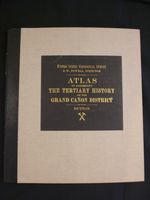
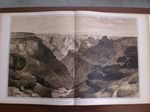

|
Dutton, Clarence Edward. Tertiary History of the Grand Canon with Atlas
to Accompany the Monograph on the Tertiary History of the Grand Canon
District (two volume set). Washington: [United States Government
Printing Office] Julius Bien & Co. Lith. New York, 1882. First edition.
Monograph. 264pp. Quarto [30.5 cm] Fine. Complete with all plates. Both
the monograph and atlas have been beautifully rebound in 3/4 black
leather over tan canvas boards. Green leather labels on both backstrips.
Atlas. Twenty-three sheets including title-page and table of contents
(sheet 1), 12 color maps, 10 color views. Folio [51.5 cm] This volume is
complete. Scarce in any condition. Hardcover.
This atlas contains the three stunning panoramas, 'From Point Sublime in
the Kaibab', by William H. Holmes. These three panoramas offer a 270
degree view of the Grand Canyon. This atlas also contains Thomas Moran's
exquisite work, 'The Transept, Kaibab Division, Grand Ca˝on An
Amphitheater of the Second Order.' These four plates have made this work
one of the most sought after Western Americana titles, and are usually
missing from this monumental work.
In 1875, Clarence Edward Dutton (1841-1912) joined the United States
Geological Survey and is known for his extensive explorations of the
Rocky Mountain region. His greatest accomplishment is his Tertiary
History of the Grand Canon District of 1882. It is still considered the
preeminent work on the Grand Canyon to date. The atlas is beautifully
illustrated with maps and views engraved by Julius Bien. Sheet XVIII of
the atlas, entitled "The Transept, Kaibab Division, Grand Canyon" is
based on the monumental painting of the same title by artist Thomas
Moran (1837-1926). Moran, more than any other artist is most closely
associated with images of the Grand Canyon. The field artist for the
Dutton geological exploration was William Henry Holmes (1846-1933).
Holmes was most noted for his sense of realism and accurate
draftsmanship. Holmes contributed many finely executed panoramic views
of the Grand Canyon to the Atlas that are quite stunning. He exhibited
at the National Academy of Design, The Art Institute of Chicago and The
Brooklyn Art Club among others. Holmes later held positions as Curator
at the University of Chicago (1898-1906) and was a former Director of
the National Academy of Design (1920-1932). Farquhar states: "One of the
greatest, if not the very greatest of all Grand Canyon books...The
atlas, containing the superb panoramic views by William H. Holmes and a
drawing by Thomas Moran, is a rich portfolio of art as well as a
collection of maps and an exposition of geology." Farquhar 73. (15547)
$10000.00
|
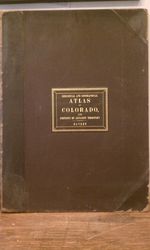


|
Hayden, Ferdinand Vandiveer. Geological and Geographical Atlas of
Colorado and Portions of Adjacent Territory by F.V. Hayden U.S.
Geologist. Washington DC: Jules Bien, 1877. First edition. Twenty
sheets. Elephant folio [68 cm] In original 3/4 leather over brown cloth
boards. Leather label at center of front board. Raised bands and title
gilt on backstrip. Very good. Bookplate on front pastedown. This
monumental work of geology and cartography is scarce in any condition.
Leather bound.
The legend states "This atlas is composed of two series of maps: the
first, of four sheets, on a scale of twelve miles to one inch, each
covering the whole State of Colorado; the second, of twelve sheets (six
topographical and six geological, of identical areas), on a scale of
four miles to one inch, each sheet embracing two and one-half degrees of
Longitude and one and one-quarter degrees of Latitude, the whole
presenting the results of the field work of 1873, '74, '75 and '76,
covering the entire State of Colorado and adjacent portions of Utah,
Arizona and New Mexico."
"Cartographically, the 1877 Atlas was the highest expression of the
labors of the Hayden Survey in Colorado." -Carl Wheat. Wheat 1281 (23744)
$4000.00
|



|
Mother Goose Rhyme: Little Bo-peep / Hickory, Dickory, Dock (large
teaching aid poster). [New York]: C. H. Congdon, 1912. Large (54" by
38") double sided poster used as a teacher's aid. One side contains
'Little Bo-peep' and the other side is 'Hickory, Dickory, Dock'. Five
charming color lithographs illustrate this piece (two for Little Bo-peep
- three for 'Hickory, Dickory Dock'). Poster. At the lower left corner
of 'Hickory' is the following notice: "This is the original form of the
Mother Goose Rhyme and the one most used. Teachers objecting to the
incorrect English will be furnished a letter 'a' on gummed paper to
place over the 'u' in run." Minor dampstaining to head and foot
otherwise clean. (26292)
$300.00
|



|
Baum, L. Frank. Mother Goose in Prose. Chicago: Way and Williams, 1897.
First edition. 265pp. Quarto [29 cm] In original gray illustrated cloth.
Very good. Corners and hinges have been professionally repaired. Three
of the plates have been supplied. Recased. Hardcover.
Warmly inscribed by Baum on the front free endsheet. Inscription reads:
"2 the 2 Ver Becks - (Pa and kid). - With sincerest admiration - and
affection of - L. Frank Baum - ?.May.1900." Presumably this is inscribed
to Frank Ver Beck, who was the illustrator of the Baum work "The Magical
Monarch of Mo."
Not only is this the first published book of L. Frank Baum, but it is
also the first illustrated work by Maxfield Parrish. This book contains
twelve charming illustrations from Parrish, in his signature style. This
is a nice inscribed copy of an increasingly uncommon work. (26090)
$15000.00
|

|
[Abbey, Ed]. Letter from Edward Abbey to the Industrial Worker. One page
letter to the editors that is dated October 1, 1988. Letter is typed and
signed at the foot. In this letter Abbey begins by thanking them for
their kind words in regards to his books, he then states that is writing
to clarify his views on immigration. Abbey states that he is "opposed to
all further mass immigration into America, legal or illegal from any
source." He goes on to write "Like all Earth Firsters, almost all
environmentalist, most union members and the majority of blacks and
Hispanics, I think we should seal our borders." He than writes his four
reasons for this position. He lists these reasons as: "(1) The USA is
overcrowded already", "(2) a large influx of cheap docile, uneducated
and desperate foreigners will put bona fide native born (or naturalized)
American working people at further disadvantage in their struggle with
big business and big government.", "(3) a growing population means
greater pressure on all resources, including clean air, schools, medical
facilities, clean water, clean soil, open space, wildlife, wilderness
and our public lands.", "(4) a growing population leads inevitably to
more government, more laws, regulations, police, centralized control,
authoritarian policies and a generalized stifling of personal freedom
for all but the very rich."
This letter evidences Abbey's longtime admiration of the wobblies and
his ties to them (evidenced in his very first novel in 1954, where the
protagonist, Jonathan Troy is described as a one eyed wobbly) as well as
his close ties to the radical environmentalist group, Earth First!,
which sprang to life in 1981 by "cracking" Glen Canyon Dam, an event at
which Abbey attended. But the meat of the letter, is Abbey's views on
immigration, spelled out in detail, and an extremely topical subject
today, some twenty-three years after he wrote it.
The Industrial Worker has been the newspaper of the Industrial Workers
of the World (IWW) since January of 1906 when the first issue was
printed in Joliet, Illinois. The IWW considers the periodical "the voice
of revolutionary industrial unionism." The IWW is still printed to this day.
Letter contains eighteen manuscript corrections by Abbey's hand in red
pen. This
letter offers rich insights into the thought and philosophy of one of
this country's leader postwar writers less than a year prior to his
untimely death at age sixty-two. (26969)
$1500.00
|
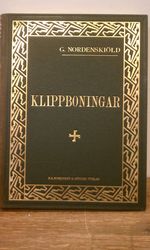

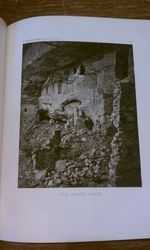
|
Nordenskiold, Gustaf. Ruiner af Klippboningar I Mesa Verde's Canons [The
Cliff Dwellers of the Mesa Verde]. Stockholm: P.A. Norstedt & Soners
Forlag, 1893. First Edition. 193pp. Folio [37 cm] Original 1/4 leather
over decorative green cloth boards with decorative gilt stamped borders
to boards and title gilt stamped on the front board. Gilt stamped title
and bands to backstrip. Very good. Backstrip shows some sunning. Head
and foot of backstrip have subtle professional repairs. Uncommon.
Hardcover.
Nordenskiold came to the American southwest in 1891 at the invitation of
Richard Wetherill, a local cattle rancher, who, along with Charles Mason
is credited with discovering the Mesa Verde ruins. This collection
contains Nordenskiold's notes and photographs of his travels and
excavations in the area. Includes all seventeen full-page plates. These
large plates include some absolutely exquisite photo gravures of the
ruins, including the double page centerfold of "The Cliff Palaces." Also
includes 159 smaller black and white illustrations. Full-page map
present at the rear. The earliest scholarly monograph on Mesa Verde.
Mesa Verde comprises some of the most spectacular American Indian ruins
in all of North America.
"I shudder to think what Mesa Verde would be today had there been no
Gustaf Nordenski÷ld. It is through his book that the cliff dwellings of
Mesa Verde became known and his volume might well be called the
harbinger of Mesa Verde National Park as we know it today." - Robert
Heyder, former National Park Superintendent. (25541)
$2000.00
|
|















